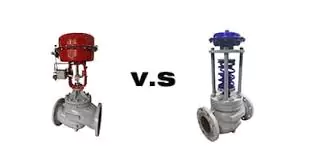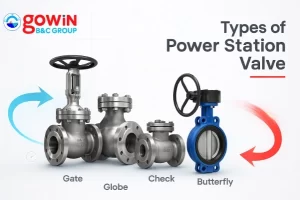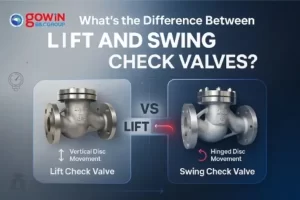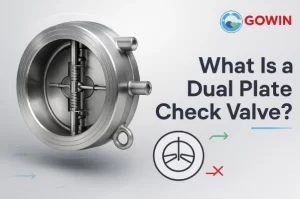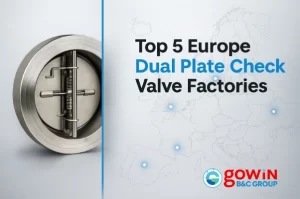Table of Contents
ToggleBoth pneumatic control valves and self-operated valves are useful in controlling the flow of fluids in a system. However, each type has its own benefits and features. So which one should you use?
A pneumatic control valve relies on compressed air to regulate the flow of liquids or gases. It offers precise and fast control, making it ideal for complex processes.
On the other hand, a self-operated control valve functions without external power. It leverages the energy from the fluid itself to adjust.
What is a Pneumatic Control Valve?
A pneumatic control valve employs air to control the flow of liquids, gases, or steam. The word “pneumatic” has a Greek origin which means “air.” Pneumatic control valves take advantage of compressed air in their operations.
Here’s how it works:
- The compressed air moves a part of the valve, called an actuator. It either opens or closes the valve. The process allows the right amount of fluid or gas to pass through.
- The valve gets signals from a controller. It will adjust itself based on what the system needs at that moment.
There are systems that need to keep the pressure of gas steady. In such environments, a pneumatic control valve is an excellent choice. These valves operate by opening or closing based on signals from the controller. They adjust the flow to maintain the correct pressure.
Advantages of Pneumatic Control Valves
- Precise control: These valves are very good at controlling things exactly. They can adjust the flow or pressure in small amounts, which is useful in complex processes.
- Fast response: They can quickly react to changes in the system. For example, if pressure suddenly rises, a pneumatic control valve can adjust almost immediately.
- Works in harsh conditions: These valves can handle tough environments like high heat, cold, or pressure. The valves are extremely useful in factories, oil plants, and chemical processing plants.
Disadvantages of Pneumatic Control Valves
- Requires air and power: Since these valves need compressed air and a controller, they can’t work on their own. They need electricity and an air supply to function.
- Expensive setup: The systems that use pneumatic control valves can cost more upfront. This is because you need extra equipment like air compressors and control systems.
- Maintenance: Because these valves have more parts (like the actuator and air supply), they need more maintenance over time.
Applications of Pneumatic Control Valves
- Oil and Gas Industry: They help control the flow of oil and gas in pipelines and refineries.
- Chemical Plants: They keep chemicals flowing at the right speed and pressure during production.
- Water Treatment Plants: They help manage the flow of water or chemicals used in treating water.
What is a Self-Operated Control Valve?
A self-operated control valve is much simpler than a pneumatic one. It doesn’t need compressed air or electricity to work. Instead, it uses the energy from the fluid or gas that flows through it to adjust itself.
Here’s how it works:
- The valve has a part inside, like a spring or diaphragm. It senses changes in pressure or temperature.
- When the pressure or temperature goes up or down, the valve moves to either let more fluid in or reduce the flow. This mechanism keeps things balanced.
For example, in a heating system, a self-operated control valve can help control the flow of steam. If the temperature gets too high, the valve will automatically close a bit. By so doing, it reduces the flow of steam and lowers the temperature.
Advantages of Self-Operated Control Valves
- No external power needed: These valves don’t need electricity or air to work. They adjust themselves using the energy from the process fluid (like steam or gas) flowing through them.
- Cheaper to install: They don’t require expensive controllers or air compressors. Therefore, they cost less to set up than pneumatic control valves.
- Simple design: Since there aren’t many moving parts, these valves are less likely to break and are easy to maintain.
Disadvantages of Self-Operated Control Valves
- Less precise: These valves can’t control flow or pressure as accurately as pneumatic ones. They’re good for basic control but not for complicated systems.
- Slower response: They take longer to react to changes in the system. If there’s a sudden change in pressure or temperature, it won’t adjust as quickly as a pneumatic control valve would.
- Limited use: They work best in simpler systems like heating or steam pressure control. They are not ideal for systems that need constant adjustments.
Applications of Self-Operated Control Valves
- Steam Systems: These valves are commonly used to regulate steam in heating systems.
- Gas Pressure Systems: They control the pressure of gas in pipelines or distribution systems.
- Water Supply: They help maintain steady pressure in water supply systems.
Key Differences Between Pneumatic Control Valves and Self-Operated Control Valves
| Feature | Pneumatic Control Valve | Self-Operated Control Valve |
| Power source | Needs compressed air and electricity | Uses the energy from the passing fluids |
| Control precision | High precision, good for complex systems | Less precise, suitable for simple systems |
| Response time | Fast, reacts quickly to changes | Slower response |
| Setup cost | Higher cost because of extra equipment | Lower cost due to simpler design |
| Best suited for | Complex processes like oil, gas, and chemical industries | Simple applications like heating or steam systems |
When to Choose A Pneumatic Control Valve
- If you need precise control of pressure, temperature, or flow in your system.
- If your system is complex and requires constant adjustments, such as in chemical plants or oil refineries.
- When you have access to compressed air and electricity to run the valve and its controller.
When to Choose A Self-Operated Control Valve
- When you need a simple, cost-effective solution that doesn’t require outside power or air.
- For systems where fine control isn’t necessary, like regulating steam in heating systems or maintaining basic water pressure.
- When you want a valve that’s easy to maintain with fewer parts that can break or need replacement.
Partner with Gowin Valves for Your Valve Needs Today
If you’re looking for high-quality valves, Gowin Valves is a name you can trust. Founded in 2007, Gowin has been providing top-tier valve solutions for industries around the world for over 16 years. The company serves a wide range of industries, including oil and gas, chemical, metallurgy, power stations, water supply, and energy industries.
Gowin offers a variety of valve types, including ball valves, gate valves, globe valves, check valves, butterfly valves, and others. They are committed to delivering reliable, high-performing valves that meet the needs of complex industrial systems.

